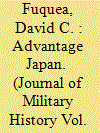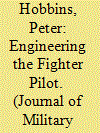|
|
|
Sort Order |
|
|
|
Items / Page
|
|
|
|
|
|
|
| Srl | Item |
| 1 |
ID:
173453


|
|
|
|
|
| Summary/Abstract |
The arrival of Japanese bombers and torpedo planes over Pearl Harbor on the morning of 7 December 1941 was a complete shock to Americans. This was not only because the two nations were at peace, but also because the Japanese naval striking force seemed to have possessed a near miraculous ability to support and supply its carriers on the long journey to and from the Japanese home islands into the heart of America's Pacific defenses. It was Japanese mastery of the logistical challenges as much as their audacity that produced the strategic surprise. The ability to keep task forces at sea refueled, regardless of weather, was a capability of which the United States Navy could only dream as the war in the Pacific began. In reality, the Imperial Japanese Navy (IJN), in the war's early years, maintained a near monopoly on large-scale, underway refueling, contributing to its "heady" early success over its American and British naval opponents.
|
|
|
|
|
|
|
|
|
|
|
|
|
|
|
|
| 2 |
ID:
173446


|
|
|
|
|
| Summary/Abstract |
The Battle of the Gates of Trajan, 17 August 986, was a landmark event in the history of the Byzantine Empire. Ambushed and annihilated by a Bulgarian army, this humiliating military reverse played a significant role in shaping the long reign of Emperor Basil II, who would rule the Byzantine Empire for another thirty-nine years and lead it to what may be regarded as its military apogee. Yet this emphasis on its legacy has left the battle itself, and the campaign which preceded it, relatively unstudied. This paper seeks to rectify this oversight by reassessing the campaign in detail, employing logistical modelling and geographical research to reconstruct the mistakes which led to one of Byzantium’s most infamous defeats.
|
|
|
|
|
|
|
|
|
|
|
|
|
|
|
|
| 3 |
ID:
173451


|
|
|
|
|
| Summary/Abstract |
The Battle of Britain (1940) is the focus of much historical controversy. We show here how the statistical technique of weighted bootstrapping can be used to create a new quantitative basis to help address such controversies. Bootstrapping facilitates the exploration of alternative campaign possibilities with different tactics. This results in comparative probabilities of “victory” for the actual and various counterfactual campaigns, providing a quantified assessment of the likelihood of German achievement of air superiority, thereby facilitating invasion. We find this more likely had the Luftwaffe targeted airfields more heavily, and greatly more likely had Germany brought forward its air campaign.
|
|
|
|
|
|
|
|
|
|
|
|
|
|
|
|
| 4 |
ID:
173450


|
|
|
|
|
| Summary/Abstract |
Whether technological superiority guarantees air superiority remains a fundamental question in air power theory. Focusing on World War II (1939–45) and the Korean conflict (1950–53), this article considers the Cotton Aerodynamic Anti-G (CAAG) suit as a putatively “war-winning” innovation. Championed by the Royal Australian Air Force, it lost out to the Canadian Franks Flying Suit worn by Royal Air Force and Fleet Air Arm flyers, and to U.S. Army Air Forces and U.S. Navy anti-G outfits. Lacking consistent policy, priority, and pilot support, the CAAG suit’s proponents failed to convert its technological advantages into doctrinal and tactical benefits.
|
|
|
|
|
|
|
|
|
|
|
|
|
|
|
|
| 5 |
ID:
173447


|
|
|
|
|
| Summary/Abstract |
New information on the problematical social and economic situation of Clausewitz’s parents makes possible a somewhat fuller reconstruction of Clausewitz’s youth. Early signs of the boy seeking an understanding of life beyond the narrow institutional limits accepted by his family, led to severe quarrels with his father, which the adult Clausewitz recalls when he finds himself in comparable conflicts in the field or in the administration of military institutions and development of policy. Jointly his innate gifts and his combative reaction to authority determine the achievements of the mature man.
|
|
|
|
|
|
|
|
|
|
|
|
|
|
|
|
| 6 |
ID:
173449


|
|
|
|
|
| Summary/Abstract |
The First World War (1914–18) saw the role of sport in British military and civil society closely dissected and widely discussed. Popular journalism, memoirs, novels, and poetry provided the British public with a regular diet of war stories and reportage in which athletic endeavor and organized games featured prominently. A study of this contemporary literary material sheds light on how far the image of the sporting warrior, and the association between games and combat, survived the horrors of industrialized killing between 1914 and 1918.
|
|
|
|
|
|
|
|
|
|
|
|
|
|
|
|
| 7 |
ID:
173448


|
|
|
|
|
| Summary/Abstract |
This article explores the political dynamics of the labor force at the federal Armory in Springfield, Massachusetts during the U. S. Civil War. The Springfield Armory, which produced firearms for the Union Army, was an actively patriotic institution within a city, state, and region very supportive of the Union cause. The Armory as an institution and many of its workers as individuals participated in Springfield's civic celebrations of Unionism and, since it was one of the most public faces of the federal government's war effort, this helped to tie the city to the conflict in a very direct way. This essay argues that, despite this projection of patriotism, the Armory was a political site where some laborers openly criticized the Lincoln administration or openly cheered the Confederacy. These men came to work at the Armory for a number of reasons, which did not always include Unionism. Their political dissent highlights both how divisive even the most patriotic of spaces on the Northern home front could be and how impressive the resolve of the Armory leadership was during the war.
|
|
|
|
|
|
|
|
|
|
|
|
|
|
|
|
| 8 |
ID:
173454


|
|
|
|
|
| Summary/Abstract |
Histories of Singapore and Hong Kong have traditionally focused on their role in British defence planning between the World Wars or the 1942 catastrophe. However, attention has recently shifted to their continued importance to Imperial security during the Cold War. This article adds to this by examining how these two fallen fortresses were restored and used to project British naval power into the Korean War. It analyses how their geopolitical conditions and security concerns affected British military power projection. It assesses the value of the fortresses through an operational lens, drawing on Korean War logistical-administrative reports and naval campaign accounts.
|
|
|
|
|
|
|
|
|
|
|
|
|
|
|
|
| 9 |
ID:
173452


|
|
|
|
|
| Summary/Abstract |
On 16 December 1941, Adolf Hitler issued his controversial Haltbefehl (Halt Order). As Germany’s Army Group Center reeled under the Soviet counterattack during the Battle for Moscow, the Haltbefehl forbade the army to retreat. Many scholars have argued that this order ended the Prussian-German command principle (Führungsprinzips) called Auftragstaktik. This principle allowed German field commanders command discretion within the intent of their superiors. This essay argues that Auftragstaktik survived at and below the divisional level during the German army’s defensive struggles. The case studies illustrate that field commanders kept their command independence and withdrew their units despite Hitler’s order.
|
|
|
|
|
|
|
|
|
|
|
|
|
|
|
|
|
|
|
|
|